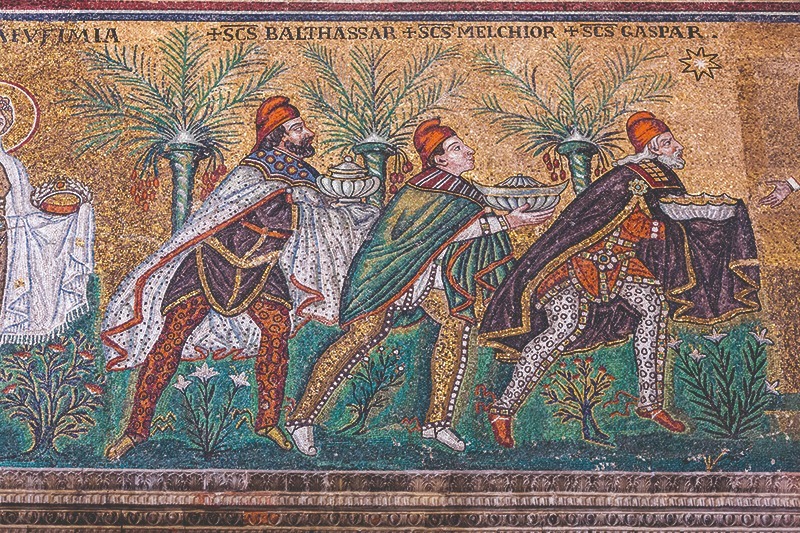
Ravenna: Capital of Empire, Crucible of Europe (Allen Lane) by Judith Herrin
Rome wasn’t built in a day; but it didn’t fall down in a day either. Empires do not disappear overnight, because they are far more than just political systems. Judith Herrin’s first major book, published over 30 years ago, was a brilliant overview of how the legacy of the Roman empire continued to shape the Mediterranean world (including nascent Islam) in the centuries after the abdication of the last western Roman emperor. In this splendid study, she traces the story through its unfolding in one very distinctive setting.
Ravenna may be well known for its unique concentration of early Christian art and architecture, but the wider cultural story in which all this belongs has never before been told in detail. What Herrin triumphantly shows is that – due to its location and many-layered political significance – this modest city in the coastal marshlands of north-eastern Italy became a crucial point of transmission for Constantinople’s imperial culture into an increasingly unstable Italy, and also a focus for negotiation between that culture and the new political realities of western Europe.
Why Ravenna? When the administrative capital of the western empire was moved north in the fourth century, first to Milan, then to Ravenna, the hope was that these provincial cities would be more easily defended than Rome, and that nearness to vulnerable frontiers with the new Germanic groups threatening the empire would make military and diplomatic responses more flexible and effective. This instinct proved right in some respects and wrong in others. The move to Ravenna did not save the imperial office in the west, already on its last legs, but it did create a functioning administrative centre that proved astonishingly durable. When the Vandal ruler Odoacer took over, he left most of this intact. Like the vast majority of “barbarian” leaders who established themselves across Europe in the wake of the western empire’s collapse, he wanted a “franchise” from the emperor in Constantinople, a recognition of his de facto authority in the west.
The Gothic king Theoderic, who overthrew Odoacer, managed to broker a remarkably successful agreement, leaving him in control of most of Italy, as well as territories in France and the Balkans. He is a key figure in the book and central to its argument. Theoderic consolidated a stable civil service, including the beginnings of an intelligence network, and won a well-deserved reputation for fair-mindedness in dealing with the diversity of his capital city. He continued the physical development of Ravenna with ambitious building projects, and recruited some of the foremost intellectuals in Europe. Indeed, the only major blot on his record is his execution of the philosopher and statesman Boethius on what were almost certainly false charges of conspiracy.
He left no adult male heir, and although his daughter Amalasuintha was exceptionally well educated and able, her regency was not popular. The ultimate outcome was the reclaiming of Ravenna and Theoderic’s Italian territories by the armies of the eastern empire and the creation of a sort of viceroy’s position in Ravenna, the “Exarchate of Italy”. It proved a precarious settlement, but it survived for a couple of centuries until the Lombard monarchy took over. By the time that Lombard rule in northern Italy was swallowed up in Charlemagne’s empire, Ravenna’s political importance was a shadow of what it had been; but Herrin ends her book with a vivid picture of Charlemagne visiting Ravenna and taking away a whole complex of royal and theological imagery and mythology, which left a deep impression on the entire subsequent history of European thinking about kingship.
Charlemagne had looked with admiration at the beautiful mosaic representations of Byzantine rulers. But he and his theological advisers were not completely won over by Byzantine ideas of royal authority. Herrin shows very clearly how Byzantine emperors’ attempts to minimise division, by imposing new solutions for theological debates in the empire, almost invariably had just the opposite effect. In Italy, the judicious management of a religiously plural population by Theoderic left a long legacy; and the increasing role and prestige of the Pope as a political mediator as well as a doctrinal authority left little room for an absolutist and theologically activist monarchy.
Herrin expertly traces the skilful improvisations that changed the face of political administration in Italy: the consolidation of military and civilian authority in one person and one system, the increasing role of local election for civic office in the cities, and the developing significance of bishops as the most widely trusted spokesmen for the interests of local communities – figures who could activate large-scale public rituals of reconciliation as well as the routine business of worship. And she rightly sees all of this as part of what Ravenna did for Europe overall.
Throughout its 300-year history as a European capital, Ravenna held together a rigorous Roman commitment to law, scholarship and public dignity with a creative pragmatism about the structures of administration and even about the theology of monarchy. The example of Theoderic, as much as that of Charlemagne, has more to do with western European unease about absolutism than we might expect.
Woven through all of this complex history is the ongoing life of the city, evoked by Herrin in a series of nicely chosen vignettes, in which we learn a bit about the trades that flourished (including the very un-Roman business of trouser-making), the interactions between Roman and Gothic communities, and the strange things that happened to the Latin language in these centuries.
At a different level, we are introduced to an intellectual life that included the transmission and adaptation of Greek medical literature and practice and the creation of an authoritative geographical record of the world known to Europeans of that era. And – given that the least of your worries in writing a book about Ravenna is going to be finding good illustrations – Herrin provides a wonderful gallery, not only of the most familiar masterpieces from Ravenna’s churches, but of coins and inscriptions as well.
Overall, this book is a triumph of accessible, innovative, lively scholarship from one of the very best Byzantine historians we have. It casts an unexpected but deeply illuminating light on how the “European” political and religious mind became what it is.
This article is from the New Humanist spring 2021 edition. Subscribe today.

